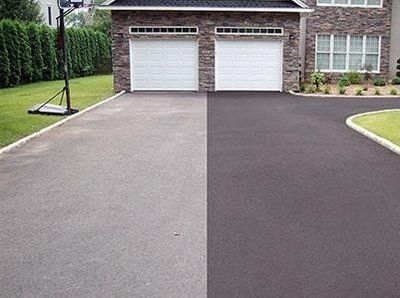Maximize Financial Investment Returns: Angled Parking Area Excellence with Asphalt Sealing
Maximize Financial Investment Returns: Angled Parking Area Excellence with Asphalt Sealing
Blog Article
Hot Mix Asphalt: A Sustainable Remedy for Pavement
Warm Mix Asphalt (HMA) has become a leading lasting selection for pavement remedies, offering a myriad of ecological benefits and ingenious technologies. Its ability to recycle materials and decrease energy consumption presents a compelling instance for its adoption in roadway building and construction tasks. The lasting efficiency and sturdiness of HMA make it a favored alternative for facilities advancement. As the need for environmentally friendly building and construction practices grows, exploring the nuances of HMA's sustainability can give useful understandings into the future of pavement services.
Ecological Benefits of Hot Mix Asphalt

Furthermore, Warm Mix Asphalt aids to mitigate urban warm island results. Its dark shade absorbs sunshine, reducing the quantity of heat reflected back right into the environment compared to lighter-colored pavements. This can decrease ambient temperature levels in metropolitan locations, lowering the need for a/c and inevitably lowering power consumption.
Additionally, Warm Mix Asphalt contributes to boosted stormwater administration. Its porous nature allows water to charge and infiltrate the sidewalk groundwater products, reducing runoff and the threat of flooding. These ecological advantages make Hot Mix Asphalt a lasting selection for leading roadways and highways.
Energy Performance in HMA Manufacturing
Is power effectiveness a critical variable in the production of Hot Mix Asphalt (HMA)? Power plays a substantial function in the manufacturing of HMA, influencing both cost and environmental sustainability. One crucial facet of energy effectiveness in HMA manufacturing is the use of warm mix asphalt (WMA) technologies.
In addition, advancements in plant innovations have actually led to more energy-efficient HMA manufacturing procedures. By optimizing power usage in HMA manufacturing, the market can decrease its carbon footprint while keeping high-grade pavement materials.
Recyclability of Hot Mix Asphalt
The recyclability of Warm Mix Asphalt (HMA) is a pivotal aspect of its sustainability and lasting ecological effect. HMA is just one of the most recycled products in the United States, with over 100 million lots of recovered asphalt sidewalk (RAP) being reused annually in brand-new pavement building and construction. Reusing HMA offers a number of ecological benefits, such as minimizing the requirement for virgin materials, decreasing energy usage throughout production, and decreasing the quantity of waste sent to garbage dumps.
The procedure of recycling HMA includes milling the existing pavement, crushing it right into smaller sized items, and mixing it with brand-new aggregate and asphalt binder to create a recycled mix. This recycled mix can usually perform in addition to and even much better than standard HMA, while calling for fewer basic materials and creating reduced greenhouse gas exhausts. By integrating RAP right into new pavement projects, roadway agencies can conserve natural deposits, lower costs, and minimize the environmental impact of roadway building and upkeep activities. Overall, the recyclability of HMA plays a substantial duty in advertising lasting techniques within the pavement sector.

Long-Term Efficiency of HMA
Asphalt pavements demonstrate durability and durability over an extended period, showing the long-term performance of Warm Mix Asphalt (HMA) The long life of HMA can be attributed to its capability Bonuses to stand up to hefty website traffic tons, harsh climate condition, and the effects of aging. Research studies have actually shown that well-designed and appropriately created HMA sidewalks can last for two decades or more with routine maintenance. The trick to optimizing the long-term performance of HMA depends on using high-quality materials, following best methods in building and construction, and implementing efficient upkeep methods. Proper water drainage, routine assessments, and timely repairs are vital for maintaining the architectural integrity of HMA sidewalks gradually. Additionally, developments in HMA technology, such as making use of polymer-modified binders and warm mix asphalt, have actually even more improved the resilience and longevity of HMA pavements. By prioritizing quality building and maintenance methods, HMA remains to confirm itself as a sustainable and affordable solution for long-lasting sidewalk infrastructure.

HMA: Sturdiness and Sustainability
Showing both durability and sustainability, Warm Mix Asphalt (HMA) has come to be a foundation in the building of durable sidewalk infrastructures - regrading. HMA's sturdiness comes from its capability to stand up to hefty loads, severe weather conditions, and high traffic volumes, making it a reliable option for roadways, highways, and flight terminal runways. The structure of HMA, which normally includes accumulations, binder, and filler, plays a crucial function in improving its long life and resistance to tear and use
Additionally, HMA's sustainability hinges on its recyclability and energy-efficient manufacturing process. The capacity to reuse redeemed asphalt sidewalk (RAP) in new HMA combinations decreases the need for virgin materials and reduces the ecological influence of pavement building and maintenance. Additionally, the energy performance of generating HMA hinges on its lower mixing temperature levels contrasted to various other sidewalk materials, resulting in minimized power intake and greenhouse gas exhausts.
Conclusion
Finally, hot mix asphalt (HMA) uses a lasting option for sidewalk with its eco pleasant characteristics. HMA's recyclability, energy performance in manufacturing, and long-lasting sturdiness make it an eco-friendly selection for roadway construction. By saving natural resources, decreasing waste, and reducing greenhouse gas discharges, HMA visit plays a critical role in promoting sustainability in infrastructure advancement. Its ability to reduce urban heat island effects further emphasizes its significance in producing resilient and environmentally conscious pavement systems.
HMA is one of the most recycled materials in the United States, with over 100 million tons of reclaimed asphalt sidewalk (RAP) being reused each year in brand-new sidewalk construction.The procedure official site of recycling HMA entails grating the existing pavement, crushing it into smaller sized pieces, and blending it with new accumulation and asphalt binder to create a recycled mix.Asphalt sidewalks demonstrate durability and resilience over an extensive period, mirroring the long-term performance of Hot Mix Asphalt (HMA) In addition, developments in HMA innovation, such as the usage of polymer-modified binders and warm mix asphalt, have actually additionally enhanced the toughness and longevity of HMA pavements. The capacity to reuse redeemed asphalt pavement (RAP) in brand-new HMA combinations decreases the need for virgin products and lessens the environmental influence of sidewalk building and upkeep.
Report this page